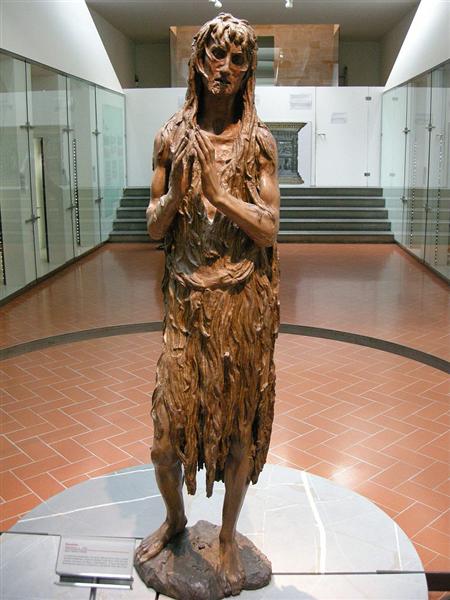Early Northern Renaissance Art - Magdalene
The Renaissance
The Renaissance began in the late 13th century and early 14th century. The Renaissance was a time of reinvention in the arts and a specific theme found in art during the Renaissance were takes on Roman and Greek culture. Italian artists started using new mediums, sizes, and perspectives in their art (Onion, et al., 2019). History states the following about the Renaissance period, "The origins of Renaissance art can be traced to Italy in the late 13th and early 14th centuries. During this so-called “proto-Renaissance” period (1280-1400), Italian scholars and artists saw themselves as reawakening to the ideals and achievements of classical Roman culture." (Onion, et al., 2019)

Photo From Magdalene, 2013
Magdalene - Who is She?
Magdalene was created by Donatello - who was famous for his life-sized sculptures and realism (Donatello, 2021). He worked mostly with goth styles and mediums such as clay or marble (The 4). Magdalene was created as a spin-off from what the bible originally made her. In the bible, they made her beautiful, young, and healthy. Donatello made a spin on this, he showed her life before she became a follower of Christ. She was living in the woods and worked as a prostitute to make it by (Magdalene, 2013). He sculpted her as very worn out, she has torn clothes and is emaciated. She also has a longing look on her face giving the impression of wanting more, being lonely, or even wishing she wasn't in such a situation. However you may spin it, she was in a terrible situation, and Donatello did an excellent job representing that.
Realism and Humanism - The Elements
Realism can be described as a realistic approach to art, meaning an accurate depiction of the art pieces to those in the real world (The 4). The sculpture shows a woman, who is accurately made in forms of size and shape of the body. Although realism is seen mostly through the more explicit sculptures, it can also be seen in more modest art. This sculpture is an example, although Magdalene is covered mostly, the curves and lines of her body show a natural shape of the body. Humanism is the approach to art that shows individualism and the human side of art. This is usually seen through the depictions in the art that show events in society, such as a dinner, or in this case, an emancipated woman, who has to prostitute herself to get by (Cartwright, 2020). Here is an accurate showing of Magdalene, and what she may have looked like before she was a follower of Christ and before she could live comfortably.
My Opinion That No One Asked For
This Magdalene sculpture is beautiful, it shows the side of a woman that no one wants to see or acknowledge. The upsetting and disturbing back story of a popular woman figure, especially in the bible. In many instances, women are seen as delicate, high maintenance, and in distress. Many members of the feminist movement have been working hard to show that women can be just as intelligent, witty, and successful as men. This makes it hard to see the bad times women can go through. Giving the world another "example" of how women are incapable of being by themselves and independent. But, I believe that we need more people to show their weak sides and share the hard times they went through. This will not only show that women can go through tough times and still come out on the other side, but it can also apply to the fact that everyone has bad times and periods in their life. This accurate and natural depiction of a woman who is vulnerable and fighting to stay alive another day shows that anyone can make it to the other side. It just takes some patience.
Works Cited
Biography.com Editors. “Donatello - David, Paintings & Facts.” Biography, Hearst Magazine Media, Inc., 26 May 2021, www.biography.com/artists/donatello. Accessed 18 June 2024.
Cartwright, Mark. “Renaissance Humanism.” World History Encyclopedia, 4 Nov. 2020, www.worldhistory.org/Renaissance_Humanism/. Accessed 18 June 2024.
History.com Editors. “Articles by History.com Editors.” HISTORY.com, A&E Television Networks, 23 Aug. 2018, www.history.com/author/history. Accessed 18 June 2024.
“Magdalene Penitent, 1453 - 1455 - Donatello - WikiArt.org.” Www.wikiart.org, www.wikiart.org/en/donatello/magdalene-penitent. Accessed 18 June 2024.
“The 4 Most Famous Renaissance Artists (and Ninja Turtles).” Brainscape Academy, 29 Oct. 2020, www.brainscape.com/academy/famous-renaissance-artists-ninja-turtles/. Accessed 18 June 2024.


I've never heard of this sculpture, I wish I had! I love the tiny details Donatello sculpted to really show how human Magdalene was. It almost seems like the face of a woman who's given up; it's sad. Your take on the humanistic side of the sculpture was spot on, and it perfectly showcases the best of the Renaissance: a humanistic approach to religious figures. No longer were the figures of the Bible out of reach for most to identify, now people could look and see that "Hey, Magdalene was human, just like me!". It's a great sculpture, and I wish it got more recognition like his depiction of David.
ReplyDeleteWhen I first saw this sculpture I was shocked at just how... disturbing it was. The hollowness of her eyes, the state of her clothes, the gaunt shapes of her body, all coming together to make me wonder, "My goodness, what did this poor woman go through?" Well, It seems like she went through a lot and you really hit the nail on the head with your thorough analysis. You gave me all the information I needed to fully appreciate the work that Donatello put into this sculpture. I also find it very fitting that the elements in which he sculpts are considered "goth," it just sounds really metal to me, haha. All fun aside, you did a lovely job telling the story this piece represents, and I loved your piece on why this work is relevant even today.
ReplyDelete